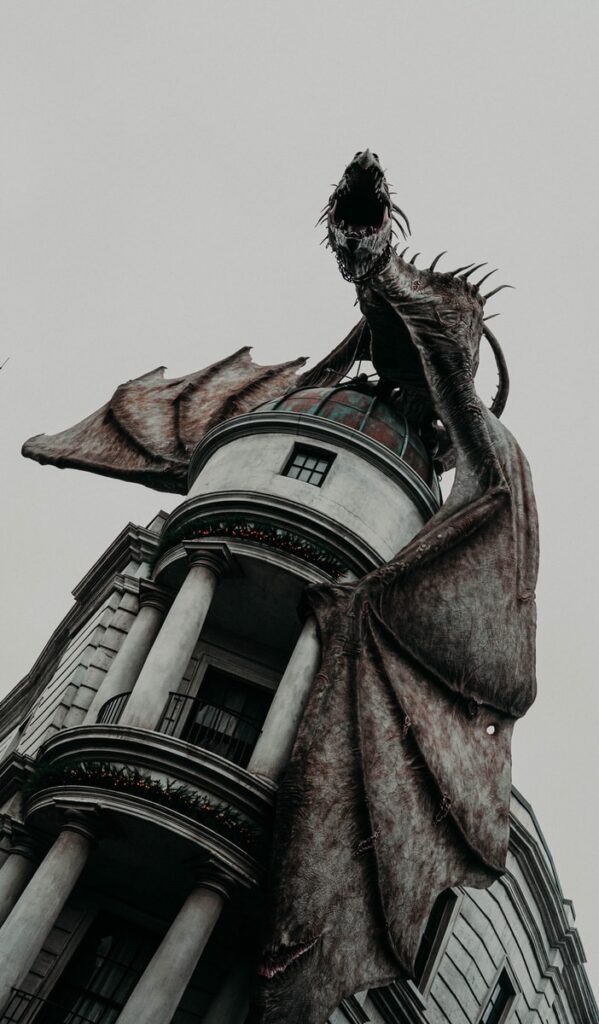EVERYTHING IN ONE MOMENT
“The Dragon flew with fierce intent towards the castle on Mount Lyre”
You read that line and you’re pretty certain of what kind of story you are getting into. You have a fairly clear image in your head. You see the clouds in the sky. You hear the beating wings of the dragon. You know things that haven’t yet been written.
Your brain doesn’t need to apply much effort to know what the words imply. If I mention the Egyptian curse, you will probably picture the Pyramids and Mummys. If I start a scene in an abandoned house beneath a full moon you wouldn’t be at all surprised to know that werewolf is nearby or that the ghosts are expecting us.

What voo-doo is going on that we know so much when we’ve heard and seen so little?
CIRCLE OF EXPECTATIONS: The assumptions we have surrounding the ideas that are presented to us.
All our lives we’ve been taught from our experiences about what comes next. The waiter comes to the table and we all predict the same words because we’ve experienced them in one way or another before. “Can I get you a drink to start? Have you had a chance to look at the menu? May I tell you about our specials tonight?”
We know everything in one moment.
Experiments by Princeton psychologists Janine Willis and Alexander Todorov showed that with only a tenth of a second to pass judgement, we make lasting decisions by just glancing at a stranger’s face.
So how does this affect our improvisation? It makes our improvisation interactions easy. (or it should – if only we’d get out of the damned way!)
Some performers say, “But the obvious choices seems cliche and I want to be different/unique”.
Improvisers avoid being obvious because of their big, fat egos saying that they are better than the truth that the audience wants to hear. Or worse, they say that the audience doesn’t want the obvious. THEY DO!
Instead of the danger we all expect to confront in a dark back alley, the “special” improviser makes a screaming banana peel that wants to be put on a falafel. Crazy. What does the audience want? Run up against the knife wielding gangster who lured us here.
Fulfill the promise in the audience’s imagination and then add something unique and within the realm of possibility. The audience will follow you greedily wanting more. That’s a much better outcome to them giggling at your talking banana and then losing interest because the story is just too weird..

The Game of EXPECTATIONS
1
One person starts to create an image (this could be done visually, but lets start with verbally.) Try NOT to make this a story or have any promise of it becoming a story. Try to be detailed with the image though.
Example:
The woman was in a cabin.
That’s OK – but specific details will be much more helpful so let’s add age and location.
The 85 year old witch, Annette Johanssen, rocked in the rocking chair in her cabin in the Whispering Forest.
None of that is storytelling. Age, name, occupation, location action are just the details that inspire me as I create one detail after another.
2
Everybody relaxes and listens to the image unfolding. As soon as they know what this story is likely to be about, they raise their hand and continue the story, filling in what they expect should occur.
If there is more than one person with raised hand then have them give it a go after the first person ends.
These story continuations should only be a line or two.
“The children came by as the witch expected. She lured them in with sweets and poisoned cookies”
That’s a POSSIBLE story that we might expect.
3
When everyone who is inspired by the first sentence has made their suggestions, ask the group which story they feel is most likely to occur. You could even chat about why other stories seem less likely to happen if people want feedback.
This is an instant feedback exercise that helps us understand what is in the audience’s mind.
Repeat the exercise. Give everyone a chance to supply that opening image because the opening image is a challenging task itself to work on. Create the image and detail. Don’t try to create the story or conflict. That’s for other’s to do. There’s no pressure to tell a story so just enjoy creating the image.
A few things to think about
At first people will be reluctant to put up their hands because they think they might be wrong. This is a reason people don’t go into scenes that need them or the reason why we don’t define details. We don’t want to be wrong.
Remind them that there is NO STORY to ruin. When the 1st person speaks it’s only an image that they’re offering you to play with. That image can inspire a thousand “correct” stories. Train yourself to be brave, to step forward with an opinion that supports the images that are being put forward. Then you become a better partner.
If no one is inspired to raise their hand when you speak your first line. It could be that the image lacked detail OR because the other improvisers are too scared to define too early. If the problem is the lack of details, say the next line describing your image/environment but take a risk and be more specific this time.
If the problem is that no one speaks up, remind them that this is training for them to react to the slightest inspiration. (For a very reluctant group have everyone come up with one idea one after the idea… Use this as a last resort. We don’t want improvisation by order. We want improvisation by inspiration.
Listen closely to the initial speaker. They might be feeling some pressure to come up with something “good” and are likely to create something negative or with conflict. That’s what stressed improvisers do when they start the scene. Remind them, their job is to create images and not to look forward or come up with a story or concept. Their task is to stay present and paint an image with detail. Practice creating a boring image with lots of detail. You’ll be surprised at what it inspires in the minds of others.



